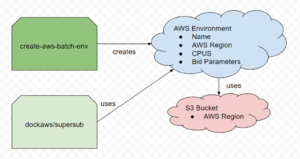AWS:Submit docking job
Jump to navigation
Jump to search
Prerequisites
- You've followed the tutorial for setting up the environment: AWS DOCK Environment Setup
- Following from the previous requirement, you have the aws-setup docker image installed on your machine (we will continue using it in this tutorial)
- Likewise, you will need to know your AWS access key, secret key, etc.
Copying data to Amazon S3
In the previous tutorial, you created an S3 bucket to set up your environment. S3 buckets act like virtual hard drives, with familiar operations like cp, ls, rm, and mv for storing & manipulating data.
In an AWS docking environment, S3 buckets are responsible for storing dockfiles, input, and output for docking runs. Typically, docking input is sourced from our lab's zinc3d bucket, which houses an enormous amount of db2 data for large docking screens, while dockfiles, output, and other configuration are saved to an environment-specific bucket. For custom screens, like DUDE-Z, input can be uploaded to & sourced from the environment-specific bucket instead.
